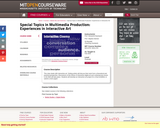
See description under subject MAS.478.
- Subject:
- Arts and Humanities
- Material Type:
- Full Course
- Provider:
- MIT
- Provider Set:
- MIT OpenCourseWare
- Author:
- Benton, Stephen
- Davenport, Glorianna
- Date Added:
- 01/01/2003

See description under subject MAS.478.
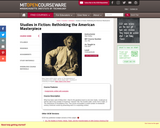
Intensive study of a range of texts by a single author or by a limited group of authors whose achievements are mutually illuminating. Some attention to narrative theory, and biographical and cultural backgrounds. Instruction and practice in oral and written communication. Topic: Joyce's Ulysses and Its Legacy.
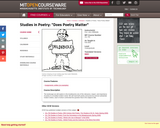
Extensive reading of works by a few major poets. Emphasizes the evolution of each poet's work and the questions of poetic influence and literary tradition. Instruction and practice in oral and written communication. Topic for Fall: Does Poetry Matter? Topic for Spring: Gender and Lyric Poetry. From the course home page Course Description The landscape we will explore is the troublesome one of the relevance, impact, and importance of poetry in a troubled modern world. We will read both poetry and prose by several substantial modern writers, each of whom confronted the question that is the subject's title.
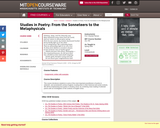
Extensive reading of works by a few major poets. Emphasizes the evolution of each poet's work and the questions of poetic influence and literary tradition. Instruction and practice in oral and written communication. Topic for Fall: Does Poetry Matter? Topic for Spring: Gender and Lyric Poetry.

Sarah E. Goode was one of the first African-American women to get a US patent. Working in her furniture store, she recognized a need for a multi-use bed and through hard work, ingenuity, and determination, invented her unique cupboard bed. She built more than a piece of furniture. She built a life far away from slavery, a life where her sweet dreams could come true. The resource includes a lesson plan/book card, a design challenge, and copy of a design thinking journal that provide guidance on using the book to inspire students' curiosity for design thinking. Maker Challenge: Your school has had an influx of new students and every class seems to be bursting at the seams! You have an additional 10 students just in your classroom alone. Because of this limited space, your school is looking for solutions. They decided that every student is going to get a new desk and chair, but it’s going to be PORTABLE. That way, you can take your desk & chair with you wherever you might go.
A document is included in the resources folder that lists the complete standards-alignment for this book activity.
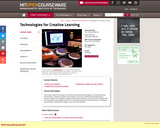
"This course explores the design of innovative educational technologies and creative learning environments, drawing on specific case studies such as the LEGOĺ¨ Programmable Brick, Scratch software and Computer Clubhouse after-school learning centers. Includes activities with new educational technologies, reflections on learning experiences, and discussion of strategies and principles underlying the design of new tools and activities."

At a time when most African Americans were slaves, Benjamin Banneker was born free in 1731. Known and admired for his work in science, mathematics, and astronomy, he built a strike clock based on his own drawings and using a pocket-knife at the age of 22. The resource includes a lesson plan/book card, a design challenge, and copy of a design thinking journal that provide guidance on using the book to inspire students' curiosity for design thinking. Maker Challenge: Find a discarded object that can be taken apart. Take apart the item and make your own Things Come Apart arrangement.
A document is included in the resources folder that lists the complete standards-alignment for this book activity.
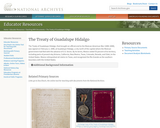
This lesson presents documents pertaining to the treaty that brought an official end to the Mexican-American War. Materials for teachers and links to other resources accompany the documents.

In order to show the world that the completed Brooklyn Bridge was strong enough, P.T. Barnum and his twenty-one elephants parade across to prove to everyone that the bridge is safe. The resource includes a lesson plan/book card, a design challenge, and copy of a design thinking journal that provide guidance on using the book to inspire students' curiosity for design thinking. Maker Challenge: Build a bridge between two tables or chairs that will hold one elephant per student in the class. Each student designs their own “elephant” using materials in the classroom.
A document is included in the resources folder that lists the complete standards-alignment for this book activity.
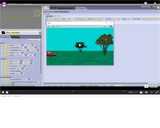
Interactive video showing how to use cameras and different camera angles to create interesting perspectives in Alice.

Students use modeling clay, a material that is denser than water and thus ordinarily sinks in water, to discover the principle of buoyancy. They begin by designing and building boats out of clay that will float in water, and then refine their designs so that their boats will carry as great a load (metal washers) as possible. Building a clay boat to hold as much weight as possible is an engineering design problem. Next, they compare amount of water displaced by a lump of clay that sinks to the amount of water displaced by the same lump of clay when it is shaped so as to float. Determining the masses of the displaced water allows them to arrive at Archimedes' principle, whereby the mass of the displaced water equals the mass of the floating clay boat.

Lonnie Johnson tried to create a new cooling system for refrigerators and air conditioners, but instead created the mechanics for one of the top twenty toys of all time, the Super Soaker. From childhood to adulthood, Lonnie had a love for rockets, robots, inventions, and a mind for creativity. He was driven toward innovation through his persistence and passion for problem solving, tinkering, and building. These traits served him well as we went on to work for NASA as an engineer. The resource includes a lesson plan/book card, a design challenge, and copy of a design thinking journal that provide guidance on using the book to inspire students' curiosity for design thinking. Maker Challenge: Students will use materials on hand to invent and design a new toy or game.
A document is included in the resources folder that lists the complete standards-alignment for this book activity.
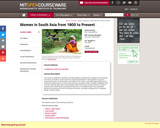
Exploration of the changes and continuities in the lives of South Asian women. Using gender as a lens, examine how politics of race, class, caste, and religion have affected women in South Asian countries, primarily in India, Pakistan, Bangladesh and Sri Lanka. Current debates within South Asian women's history illustrate the issues and problems that arise in re-writing the past from a gendered perspective. Primary documents, secondary readings, films, newspaper articles, and the Internet.

Emma Lilian Todd was a self-taught engineer who tackled one of the greatest challenges of the early 1900s: designing an airplane. As an adult, typing up patents at the U.S. Patent Office, Lilian built inventions in her mind, including many designs for flying machines. However, they all seemed too impractical. Lilian knew she could design one that worked. She took inspiration from both nature and her many failures, driving herself to perfect the design that would eventually successfully fly. The resource includes a lesson plan/book card, a design challenge, and copy of a design thinking journal that provide guidance on using the book to inspire students' curiosity for design thinking. Maker Challenge: Design a new mode of transportation (air, sea, or ground) or select a current mode of transportation and improve it then use household items to create a prototype of your new or updated invention.
A document is included in the resources folder that lists the complete standards-alignment for this book activity.

Zaha Hadid grew up in Baghdad, Iraq, and dreamed of designing her own cities. After studying architecture in London, she opened her own studio and started designing buildings. But as a Muslim woman, Hadid faced many obstacles. Determined to succeed, she worked hard for many years, and achieved her goals—and now you can see the buildings Hadid has designed all over the world. The resource includes a lesson plan/book card, a design challenge, and copy of a design thinking journal that provide guidance on using the book to inspire students' curiosity for design thinking. Maker Challenge: Identify an area in your school that is very traditional. Redesign it to better fit the needs of the end-users. Then sketch out a new design, and then create a physical prototype of the new design to scale.
A document is included in the resources folder that lists the complete standards-alignment for this book activity.
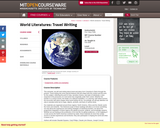
"This semester, we will read writing about travel and place from Columbus's Diario through the present. Travel writing has some special features that will shape both the content and the work for this subject: reflecting the point of view, narrative choices, and style of individuals, it also responds to the pressures of a real world only marginally under their control. Whether the traveler is a curious tourist, the leader of a national expedition, or a starving, half-naked survivor, the encounter with place shapes what travel writing can be. Accordingly, we will pay attention not only to narrative texts but to maps, objects, archives, and facts of various kinds. Our materials are organized around three regions: North America, Africa and the Atlantic world, the Arctic and Antarctic. The historical scope of these readings will allow us to know something not only about the experiences and writing strategies of individual travelers, but about the progressive integration of these regions into global economic, political, and knowledge systems. Whether we are looking at the production of an Inuit film for global audiences, or the mapping of a route across the North American continent by water, these materials do more than simply record or narrate experiences and territories: they also participate in shaping the world and what it means to us. Authors will include Olaudah Equiano, Caryl Philips, Claude L?vi-Strauss, Joseph Conrad, Jamaica Kincaid, William Least Heat Moon, Louise Erdrich, ?lvar N
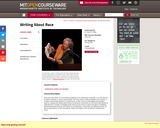
Does race still matter, as Cornel West proclaimed in his 1994 book of that title, or do we now live, as others maintain, in a post-racial society? The very notion of what constitutes race remains a complex and evolving question in cultural terms. In this course we will engage this question head-on, reading and writing about issues involving the construction of race and racial identity as reflected from a number of vantage points and via a rich array of voices and genres. Readings will include literary works by such writers as Toni Morrison, Junot Diaz, and Sherman Alexie, as well as perspectives on film and popular culture from figures such as Malcolm Gladwell and Touré.
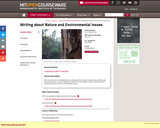
This course focuses on traditional nature writing and the environmentalist essay. Students will keep a web log as a journal. Writings are drawn from the tradition of nature writing and from contemporary forms of the environmentalist essay.
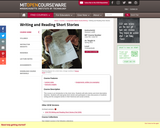
This course is an introduction to the short story. Students will write stories and short descriptive sketches. Students will read great short stories and participate in class discussions of students' writing and the assigned stories in their historical and social contexts.